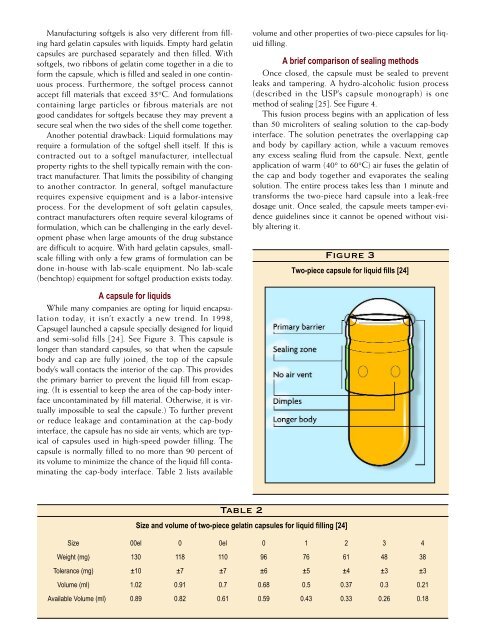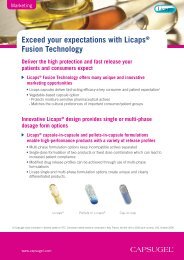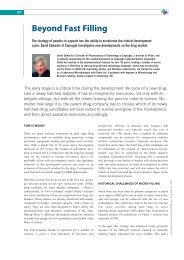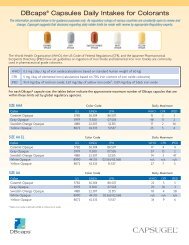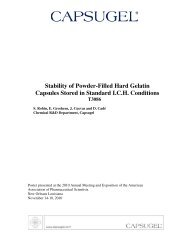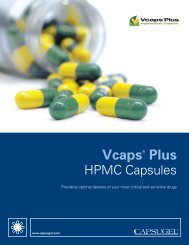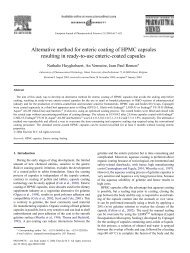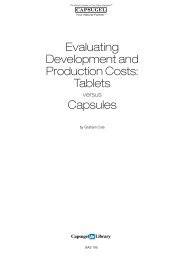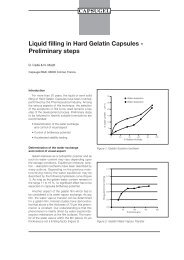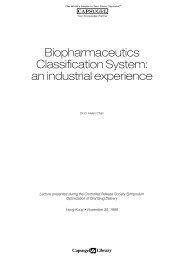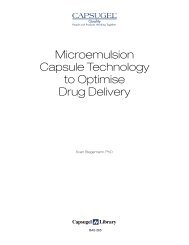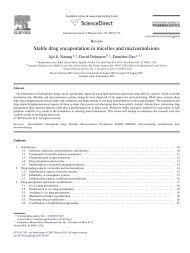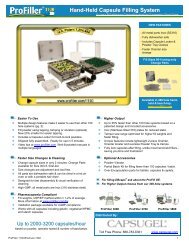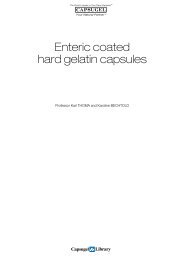Filling two-piece hard gelatin capsules with liquids - Capsugel
Filling two-piece hard gelatin capsules with liquids - Capsugel
Filling two-piece hard gelatin capsules with liquids - Capsugel
Create successful ePaper yourself
Turn your PDF publications into a flip-book with our unique Google optimized e-Paper software.
Manufacturing softgels is also very different from filling<br />
<strong>hard</strong> <strong>gelatin</strong> <strong>capsules</strong> <strong>with</strong> <strong>liquids</strong>. Empty <strong>hard</strong> <strong>gelatin</strong><br />
<strong>capsules</strong> are purchased separately and then filled. With<br />
softgels, <strong>two</strong> ribbons of <strong>gelatin</strong> come together in a die to<br />
form the capsule, which is filled and sealed in one continuous<br />
process. Furthermore, the softgel process cannot<br />
accept fill materials that exceed 35°C. And formulations<br />
containing large particles or fibrous materials are not<br />
good candidates for softgels because they may prevent a<br />
secure seal when the <strong>two</strong> sides of the shell come together.<br />
Another potential drawback: Liquid formulations may<br />
require a formulation of the softgel shell itself. If this is<br />
contracted out to a softgel manufacturer, intellectual<br />
property rights to the shell typically remain <strong>with</strong> the contract<br />
manufacturer. That limits the possibility of changing<br />
to another contractor. In general, softgel manufacture<br />
requires expensive equipment and is a labor-intensive<br />
process. For the development of soft <strong>gelatin</strong> <strong>capsules</strong>,<br />
contract manufacturers often require several kilograms of<br />
formulation, which can be challenging in the early development<br />
phase when large amounts of the drug substance<br />
are difficult to acquire. With <strong>hard</strong> <strong>gelatin</strong> <strong>capsules</strong>, smallscale<br />
filling <strong>with</strong> only a few grams of formulation can be<br />
done in-house <strong>with</strong> lab-scale equipment. No lab-scale<br />
(benchtop) equipment for softgel production exists today.<br />
volume and other properties of <strong>two</strong>-<strong>piece</strong> <strong>capsules</strong> for liquid<br />
filling.<br />
A brief comparison of sealing methods<br />
Once closed, the capsule must be sealed to prevent<br />
leaks and tampering. A hydro-alcoholic fusion process<br />
(described in the USP’s capsule monograph) is one<br />
method of sealing [25]. See Figure 4.<br />
This fusion process begins <strong>with</strong> an application of less<br />
than 50 microliters of sealing solution to the cap-body<br />
interface. The solution penetrates the overlapping cap<br />
and body by capillary action, while a vacuum removes<br />
any excess sealing fluid from the capsule. Next, gentle<br />
application of warm (40° to 60°C) air fuses the <strong>gelatin</strong> of<br />
the cap and body together and evaporates the sealing<br />
solution. The entire process takes less than 1 minute and<br />
transforms the <strong>two</strong>-<strong>piece</strong> <strong>hard</strong> capsule into a leak-free<br />
dosage unit. Once sealed, the capsule meets tamper-evidence<br />
guidelines since it cannot be opened <strong>with</strong>out visibly<br />
altering it.<br />
Figure 3<br />
Two-<strong>piece</strong> capsule for liquid fills [24]<br />
A capsule for <strong>liquids</strong><br />
While many companies are opting for liquid encapsulation<br />
today, it isn’t exactly a new trend. In 1998,<br />
<strong>Capsugel</strong> launched a capsule specially designed for liquid<br />
and semi-solid fills [24]. See Figure 3. This capsule is<br />
longer than standard <strong>capsules</strong>, so that when the capsule<br />
body and cap are fully joined, the top of the capsule<br />
body’s wall contacts the interior of the cap. This provides<br />
the primary barrier to prevent the liquid fill from escaping.<br />
(It is essential to keep the area of the cap-body interface<br />
uncontaminated by fill material. Otherwise, it is virtually<br />
impossible to seal the capsule.) To further prevent<br />
or reduce leakage and contamination at the cap-body<br />
interface, the capsule has no side air vents, which are typical<br />
of <strong>capsules</strong> used in high-speed powder filling. The<br />
capsule is normally filled to no more than 90 percent of<br />
its volume to minimize the chance of the liquid fill contaminating<br />
the cap-body interface. Table 2 lists available<br />
Table 2<br />
Size and volume of <strong>two</strong>-<strong>piece</strong> <strong>gelatin</strong> <strong>capsules</strong> for liquid filling [24]<br />
Size 00el 0 0el 0 1 2 3 4<br />
Weight (mg) 130 118 110 96 76 61 48 38<br />
Tolerance (mg) ±10 ±7 ±7 ±6 ±5 ±4 ±3 ±3<br />
Volume (ml) 1.02 0.91 0.7 0.68 0.5 0.37 0.3 0.21<br />
Available Volume (ml) 0.89 0.82 0.61 0.59 0.43 0.33 0.26 0.18


